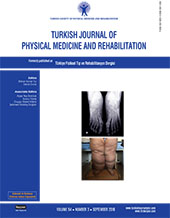The association of patellar maltracking with infrapatellar fat pad edema and chondromalacia patella: A quantitative morphological magnetic resonance imaging analysis
2 Department of Orthopaedics and Traumatology, İzmir Katip Çelebi University Atatürk Training and Research Hospital, İzmir, Turkey
3 Department of Orthopaedics and Traumatology, Yenimahalle Training and Research Hospital, Ankara, Turkey DOI : 10.5606/tftrd.2018.1586 Objectives: This study aims to investigate the relationship of patellofemoral joint morphology with infrapatellar fat pad edema and chondromalacia patella (CP) using patellar maltracking parameters on magnetic resonance imaging (MRI).
Patients and methods: Between January 2010 and January 2013, 50 patients with edema in the superolateral portion of the infrapatellar fat pad (the study group) and control group (n=50) with a normal infrapatellar fat pad were identified on MRI to compare with regard to five patellar maltracking parameters retrospectively. These parameters were trochlear depth, the trochlear sulcus angle (TSA), patellar translation, the lateral patellofemoral angle (PFA), and the Insall-Salvati ratio. The relationship between patellar maltracking and the CP was also evaluated using the same parameters.
Results: In the study group, the Insall-Salvati index and TSA were significantly higher (p=0.001), and the trochlear depth and PFA were low (p=0.001, p=0.01), while patellar translation showed no difference (p=0.957). In the CP group, the Insall-Salvati index and TSA were significantly high (p=0.001), the trochlear depth was low (p=0.001). No statistically significant difference was found in PFA and patellar translation (p=0.292, p=0.446).
Conclusion: Our study results suggest that edema in the superolateral portion of infrapatellar fat pad and CP are associated with patellar maltracking.
Keywords : Chondromalacia patella; infrapatellar fat pad; magnetic resonance imaging; patellar maltracking

















